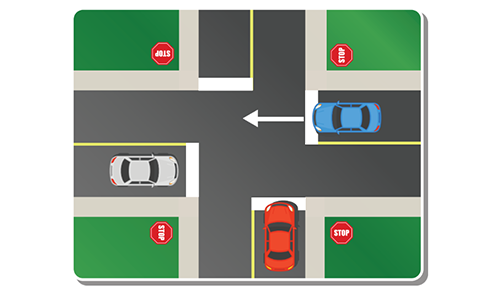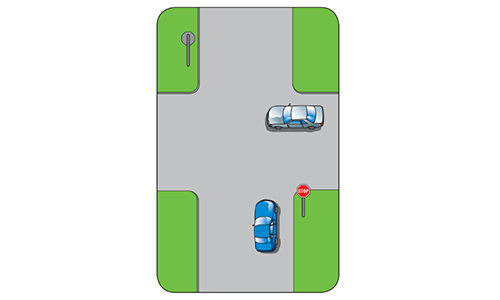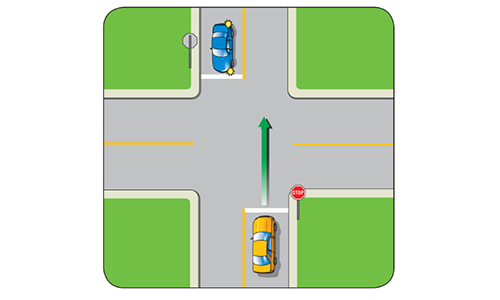Right-of-Way Rules
- 1/30When approaching an intersection on a main road that is blocked by traffic.
Entering an intersection when it is blocked can obstruct cross traffic. Stopping before entering ensures you do not block the intersection and allows smoother traffic flow.

At a four-way stop, the fundamental rule is that the vehicle that arrives first at the intersection and comes to a full stop has the right-of-way.

When two vehicles arrive simultaneously at a four-way stop, the driver of the vehicle on the right has the right-of-way.

When two vehicles facing each other arrive at a four-way stop at the same time, the vehicle intending to turn left must yield to the vehicle that is proceeding straight through.
Approaching an intersection with a red light, the required action is
A red light means you must stop and wait until the light turns green to proceed. This rule helps in managing traffic flow and preventing accidents.
Upon seeing a stop sign at an intersection
At a stop sign, you must come to a complete stop, check for other vehicles and pedestrians, and only proceed when it is safe to do so.
A controlled intersection means
Controlled intersections are identified by the presence of signs (like stop or yield) or traffic lights that dictate driver behavior.
Uncontrolled intersections can be particularly dangerous because
Lacking signs or signals, uncontrolled intersections can be dangerous because drivers may not expect conflicting movements from other road users.
At an uncontrolled intersection, if two vehicles arrive at the same time, the vehicle that must yield is
When two vehicles arrive simultaneously at an uncontrolled intersection, the driver on the left must yield the right-of-way to the vehicle on the right.
When turning left at an uncontrolled intersection with oncoming traffic
At an uncontrolled intersection, a driver intending to turn left must yield to any oncoming traffic that is in or near the intersection.
If you are going straight through an uncontrolled intersection and another vehicle is already in the intersection turning left
Even if you intend to go straight, if another vehicle is already in the uncontrolled intersection legally making a left turn, you must yield to them.
If there is a stop line at an intersection
The stop line indicates the precise point where you are legally required to stop your vehicle before entering the intersection.
If an intersection has a crosswalk but no stop line
In the absence of a stop line, the rule is to stop immediately before the marked crosswalk to allow pedestrians safe passage.
At an intersection with no stop line, crosswalk, or sidewalk, the correct stopping position is
If no other markings are present, drivers must stop at a point just before their vehicle would enter the physical boundaries of the intersection.
A steady red traffic light always indicates
A steady red light is a mandatory stop signal, requiring drivers to bring their vehicle to a complete halt.
Upon encountering a fresh green light, the recommended action before moving forward is
Even when a light just turns green, it is essential to scan the intersection for any vehicles, cyclists, or pedestrians who might still be in the intersection or trying to beat a red light.
When making a left turn on a steady green light
On a steady green light, drivers making a left turn must yield to all through-traffic coming from the opposite direction and wait for a safe opening to complete their turn.
A steady yellow traffic light indicates
A yellow light means the signal is changing to red, and drivers should stop before the intersection unless they are too close to do so safely.
If you are in an intersection waiting to make a left turn and the light turns yellow
A driver already in the intersection lawfully waiting to complete a left turn may proceed to do so, even if the light turns yellow, but must watch for other vehicles.
A flashing green light at an intersection signifies
A flashing green light indicates that through traffic has a continuous green, while traffic on the intersecting street or side road is facing a stop sign. Pedestrians may also activate a signal change.
Upon encountering a flashing red traffic light, the required action is
A flashing red light functions as a stop sign, requiring a complete stop before proceeding only when the intersection is clear and safe.
At a two-way stop intersection, the traffic that generally has the right-of-way is
Vehicles on the through street, which does not have stop signs, typically have the right-of-way at a two-way stop intersection.
If two vehicles arrive at a two-way stop and are both stopped, and one driver wishes to turn left, the usual right-of-way rule is
At a two-way stop, if two vehicles are stopped, the driver intending to turn left generally must yield to the vehicle that is not turning left.
When facing a green light at a controlled intersection
A green light means you can proceed, but you should be prepared for the light to change to yellow. Maintaining a steady speed helps in making safe and predictable driving decisions.
At an uncontrolled intersection with no signs or traffic lights, if two vehicles arrive at the same time, the rule is
At an uncontrolled intersection, the vehicle on the left must yield to the vehicle on the right. This rule helps in determining the right-of-way when there are no clear signals.
At an intersection with stop signs at all corners, the rule for yielding is
At an intersection with stop signs, the first vehicle to stop has the right-of-way. This helps in managing the flow of traffic and reducing the risk of collisions.
When you want to turn left at an intersection
When turning left, you must yield to oncoming traffic and pedestrians to ensure a safe turn and avoid collisions.
When entering a road from a private road or driveway
Vehicles entering a road from a private road or driveway must yield to all road traffic and pedestrians to prevent accidents.
When approaching a pedestrian crossover, you should
At pedestrian crossovers, yielding to pedestrians and waiting until they have fully crossed ensures their safety and complies with traffic laws.
When handling a yield sign at an intersection, the correct action is
A yield sign requires you to slow down or stop as needed and yield to any traffic already in or approaching the intersection.
 Flash Sales ends
Flash Sales ends  Get Subscription is just only
Get Subscription is just only 



